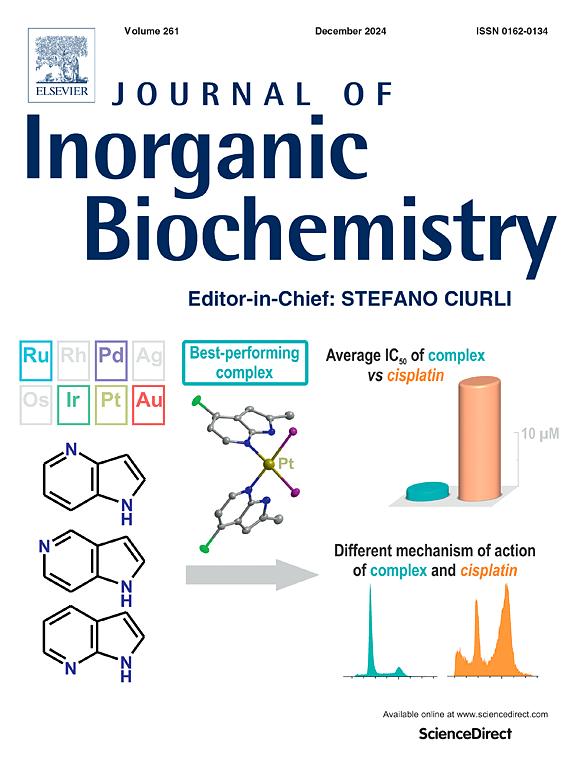Probing the generation, reactivity, and kinetics of high-valent manganese-oxo phthalocyanines: Insights into oxidation mechanisms
IF 3.8
2区 化学
Q2 BIOCHEMISTRY & MOLECULAR BIOLOGY
引用次数: 0
Abstract
In this study, manganese(IV)-oxo phthalocyanines [MnIV(Pc)(O)] (3) (Pc = phthalocyanine) were produced either through visible light photolysis of [MnIII(Pc)(ClO3)] or by chemical oxidation of [MnIII(Pc)Cl] (1) with iodobenzene diacetate. The manganese(IV)-oxo species under study include tetra-tert-butylphthalocyaine‑manganese(IV)-oxo (3a) and phthalocyanine‑manganese(IV)-oxo (3b). As anticipated, the generated 3 reacted with various organic substrates to yield the oxidized products and further proved to be a competent oxidant via an H218O isotope labeling experiment. The kinetics of oxygen atom transfer (OAT) reactions for these generated 3 species with a range of substrates were examined in CH3CN solutions unless other specified. Overall, the second-order rate constants under pseudo-first-order conditions for 3a and 3b with the same substrates display similar modest reactivity, with the nature of the substrate playing a major role in influencing the reactivity of species 3. The phenol substrates, in particular, reacted the fastest. Of note, second-order rate constants determined for thioanisoles are comparable to those of alkene epoxidations and activated C![]() H bond oxidations. Conventional Hammett analyses of rate constants for substituted styrenes revealed a linear correlation with the σ constant, indicating minimal charge developed at the transition state during the oxidation process. Additionally, the competition product studies and the Hammett correlation analysis further suggested that the manganese(IV)-oxo species observed in those kinetic studies are unlikely to serve as the primary oxidant for the epoxidation reactions catalyzed by manganese(III) phthalocyanine with PhI(OAc)2.
H bond oxidations. Conventional Hammett analyses of rate constants for substituted styrenes revealed a linear correlation with the σ constant, indicating minimal charge developed at the transition state during the oxidation process. Additionally, the competition product studies and the Hammett correlation analysis further suggested that the manganese(IV)-oxo species observed in those kinetic studies are unlikely to serve as the primary oxidant for the epoxidation reactions catalyzed by manganese(III) phthalocyanine with PhI(OAc)2.

探究高价锰氧酞菁的生成、反应性和动力学:氧化机制的见解
在本研究中,锰(IV)-氧酞菁[MnIV(Pc)(O)] (3) (Pc =酞菁)通过可见光光解[MnIII(Pc)(ClO3)]或用二醋酸碘苯化学氧化[MnIII(Pc)Cl](1)来生产。所研究的锰(IV)-氧物种包括四叔丁基酞菁-锰(IV)-氧(3a)和酞菁-锰(IV)-氧(3b)。正如预期的那样,生成的3与各种有机底物反应生成氧化产物,并通过H218O同位素标记实验进一步证明了它是一种称职的氧化剂。除非另有说明,否则在CH3CN溶液中研究了这3种物质与一系列底物的氧原子转移(OAT)反应动力学。总体而言,相同底物的3a和3b在拟一阶条件下的二阶速率常数显示出相似的适度反应性,其中底物的性质对物种3的反应性起主要作用。特别是苯酚底物,反应速度最快。值得注意的是,硫代苯甲醚的二阶速率常数与烯烃环氧化和活化CH键氧化的二阶速率常数相当。传统的Hammett分析表明取代苯乙烯的速率常数与σ常数呈线性相关,表明在氧化过程中过渡态产生了最小电荷。此外,竞争产物研究和Hammett相关分析进一步表明,这些动力学研究中观察到的锰(IV)-氧不太可能作为锰(III)酞菁与PhI(OAc)2催化环氧化反应的主氧化剂。
本文章由计算机程序翻译,如有差异,请以英文原文为准。
求助全文
约1分钟内获得全文
求助全文
来源期刊

Journal of Inorganic Biochemistry
生物-生化与分子生物学
CiteScore
7.00
自引率
10.30%
发文量
336
审稿时长
41 days
期刊介绍:
The Journal of Inorganic Biochemistry is an established international forum for research in all aspects of Biological Inorganic Chemistry. Original papers of a high scientific level are published in the form of Articles (full length papers), Short Communications, Focused Reviews and Bioinorganic Methods. Topics include: the chemistry, structure and function of metalloenzymes; the interaction of inorganic ions and molecules with proteins and nucleic acids; the synthesis and properties of coordination complexes of biological interest including both structural and functional model systems; the function of metal- containing systems in the regulation of gene expression; the role of metals in medicine; the application of spectroscopic methods to determine the structure of metallobiomolecules; the preparation and characterization of metal-based biomaterials; and related systems. The emphasis of the Journal is on the structure and mechanism of action of metallobiomolecules.
 求助内容:
求助内容: 应助结果提醒方式:
应助结果提醒方式:


